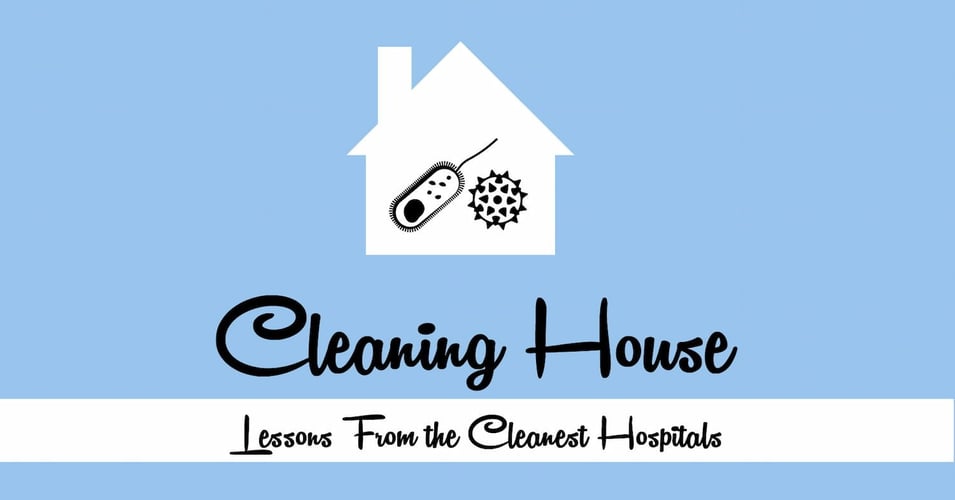Editor's Note: This post was originally published in October 2019 and has been updated for freshness, accuracy and comprehensiveness.
Hands are Surfaces: When Do We Clean and When Do We Sanitize?

As awareness of the COVID-19 virus increased, Americans everywhere rushed out to (try to) buy hand sanitizer. All of us now know that washing our hands is an essential part of not spreading the novel coronavirus. Why is hand hygiene so important in healthcare? What about in times of pandemic for the general population? Because our hands are one of the "surfaces" we interact with the most! Therefore, we have to keep them clean, and at critical times, sanitized. Today's post will explore how we clean and sanitize the most important surface: Hands.
Let's start with cleaning: The removal of debris and organic matter from the surface. For hands, all we need is plain old soap and water. The way soap removes contamination is considered mechanical rather than chemical, but chemical processes are still at work. Soap contains molecules that have a hydrophillic (water-attracting) end and a hydrophobic (water-repelling) end. These molecules work by breaking up oils and fats on the skin - where all the germs stick - and making it easier for them to be washed off. The molecules basically attach in a sphere (called a micelle) around the oil particles with the hydrophillic ends facing out, ready to get carried away by the water. Soap doesn't kill bacteria, but it gets it off the skin. This method of cleaning - removing organic matter - is a necessary step before sanitizing, which does kill bacteria.
![]() Hand sanitizers work chemically, using the alcohol molecules to actually kill the bacteria on your skin. Using a similar concept to soap, alcohol molecules also have a hydrophillic and a hydrophobic end. But alcohol-based hand sanitizers work on a much smaller scale than soap: Instead of attaching to large blobs of lipids (fats), alcohol molecules attach to the lipids that make up the bacterial cell membrane. Once they attach, they destabilize the membrane, rupturing it and exposing the fragile insides to even more alcohol molecules. When the alcohol attaches to these internal proteins, they disrupt the hydrogen bonds, killing the bacteria. For this reason, hand sanitizers are particularly helpful, if used properly, in the healthcare industry.
Hand sanitizers work chemically, using the alcohol molecules to actually kill the bacteria on your skin. Using a similar concept to soap, alcohol molecules also have a hydrophillic and a hydrophobic end. But alcohol-based hand sanitizers work on a much smaller scale than soap: Instead of attaching to large blobs of lipids (fats), alcohol molecules attach to the lipids that make up the bacterial cell membrane. Once they attach, they destabilize the membrane, rupturing it and exposing the fragile insides to even more alcohol molecules. When the alcohol attaches to these internal proteins, they disrupt the hydrogen bonds, killing the bacteria. For this reason, hand sanitizers are particularly helpful, if used properly, in the healthcare industry.
So to answer the question posed by this post: When do we clean? When do we sanitize? For hands, they should be cleaned when soiled by organic matter or other debris such as food crumbs, dirt, or grime. Only after this step should they be santized. Hand-sanitizers are not necessary for everyday life, but are very useful for healthcare workers around vulnerable patients. For surfaces, the same rules apply. Clean first to remove debris, then sanitize. For everyday use, surfaces should be sanitized after potentially contaminated spills (such as raw chicken), in bathrooms, and when someone has been sick. For heathcare facilities, ideally, all surfaces are regularly sanitized, but achieving that is difficult with environmental services alone...until now.
At a recent conference, a speaker yearned for a hand sanitizer that would have persistent antimicrobial effects, so that one application would last a healthcare worker throughout the day, continuously killing bacteria. He called this "the Holy Grail for infection prevention." (Everyone in the audience nodded enthusiastically!). While a persistent and continuous hand surface self-sanitizer is still a dream, there is a solid surface that continuously kills bacteria, even after recontamination. These copper-based materials are actually registered by the EPA as self-sanitizers and their continuous effect lasts indefinitely. These Preventive|Biocidal Surfaces use cuprous oxide to destabilize the cell membrane and destroy the internal proteins found in bacteria, much like the alcohol in hand sanitizers. The copper is embedded in the surface so that as long as it remains cleaned of visible organic matter (just like washing your hands with soap), it will continuously self-sanitize, 24 hours a day. So while healthcare workers use their hand sanitizer throughout the day to keep their hands free from excess contamination, the bedrails, overbed tables, and workstations could also be continuously sanitized. Combined, they may actually be "the Holy Grail." At the very least, the result is a win-win for all involved: Fewer HAIs.
![EOScu Logo - Dark - Outlined [07182023]-01](https://blog.eoscu.com/hubfs/Eoscu_June2024/Images/EOScu%20Logo%20-%20Dark%20-%20Outlined%20%5B07182023%5D-01.svg)

![[infographic] How Copper Kills Bacteria Download and share!](https://no-cache.hubspot.com/cta/default/216314/interactive-178388176798.png)



